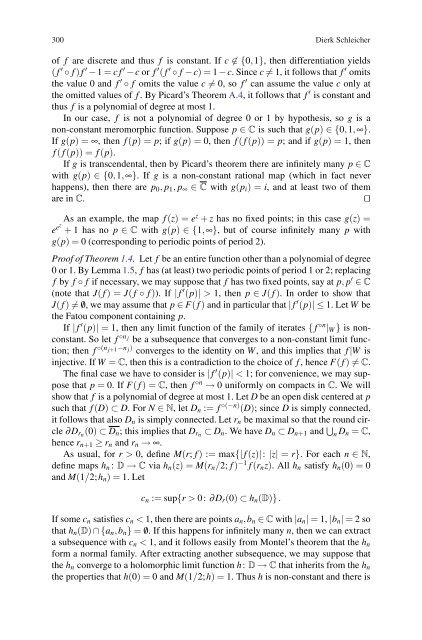Discrete Holomorphic Local Dynamical Systems
Discrete Holomorphic Local Dynamical Systems
Discrete Holomorphic Local Dynamical Systems
You also want an ePaper? Increase the reach of your titles
YUMPU automatically turns print PDFs into web optimized ePapers that Google loves.
300 Dierk Schleicher<br />
of f are discrete and thus f is constant. If c �∈ {0,1}, then differentiation yields<br />
( f ′ ◦ f ) f ′ −1 = cf ′ − c or f ′ ( f ′ ◦ f − c)=1 − c.Sincec �= 1, it follows that f ′ omits<br />
the value 0 and f ′ ◦ f omits the value c �= 0, so f ′ can assume the value c only at<br />
the omitted values of f . By Picard’s Theorem A.4, it follows that f ′ is constant and<br />
thus f is a polynomial of degree at most 1.<br />
In our case, f is not a polynomial of degree 0 or 1 by hypothesis, so g is a<br />
non-constant meromorphic function. Suppose p ∈ C is such that g(p) ∈{0,1,∞}.<br />
If g(p)=∞, thenf (p) =p; ifg(p)=0, then f ( f (p)) = p; andifg(p)=1, then<br />
f ( f (p)) = f (p).<br />
If g is transcendental, then by Picard’s theorem there are infinitely many p ∈ C<br />
with g(p) ∈{0,1,∞}. Ifg is a non-constant rational map (which in fact never<br />
happens), then there are p0, p1, p∞ ∈ C with g(pi) =i, and at least two of them<br />
are in C. ⊓⊔<br />
As an example, the map f (z) =ez + z has no fixed points; in this case g(z) =<br />
eez + 1hasnop∈Cwith g(p) ∈{1,∞}, but of course infinitely many p with<br />
g(p)=0 (corresponding to periodic points of period 2).<br />
Proof of Theorem 1.4. Let f be an entire function other than a polynomial of degree<br />
0or1.ByLemma1.5, f has (at least) two periodic points of period 1 or 2; replacing<br />
f by f ◦ f if necessary, we may suppose that f has two fixed points, say at p, p ′ ∈ C<br />
(note that J( f )=J( f ◦ f )). If | f ′ (p)| > 1, then p ∈ J( f ). In order to show that<br />
J( f ) �= /0, we may assume that p ∈ F( f ) and in particular that | f ′ (p)|≤1. Let W be<br />
the Fatou component containing p.<br />
If | f ′ (p)| = 1, then any limit function of the family of iterates { f ◦n |W } is nonconstant.<br />
So let f ◦n j be a subsequence that converges to a non-constant limit function;<br />
then f ◦(n j+1−n j) converges to the identity on W, and this implies that f |W is<br />
injective. If W = C, then this is a contradiction to the choice of f , hence F( f ) �= C.<br />
Thefinalcasewehavetoconsideris| f ′ (p)| < 1; for convenience, we may suppose<br />
that p = 0. If F( f )=C, then f ◦n → 0 uniformly on compacts in C. We will<br />
show that f is a polynomial of degree at most 1. Let D be an open disk centered at p<br />
such that f (D) ⊂ D. ForN ∈ N, letDn := f ◦(−n) (D); sinceD is simply connected,<br />
it follows that also Dn is simply connected. Let rn be maximal so that the round cir-<br />
cle ∂Drn (0) ⊂ Dn;thisimpliesthatDrn ⊂ Dn. WehaveDn ⊂ Dn+1 and �<br />
n Dn = C,<br />
hence rn+1 ≥ rn and rn → ∞.<br />
As usual, for r > 0, define M(r; f ) := max{| f (z)|: |z| = r}. For each n ∈ N,<br />
define maps hn : D → C via hn(z) =M(rn/2; f ) −1 f (rnz). Allhn satisfy hn(0)=0<br />
and M(1/2;hn)=1. Let<br />
cn := sup{r > 0: ∂Dr(0) ⊂ hn(D)}.<br />
If some cn satisfies cn < 1, then there are points an,bn ∈ C with |an| = 1, |bn| = 2so<br />
that hn(D) ∩{an,bn} = /0. If this happens for infinitely many n, then we can extract<br />
a subsequence with cn < 1, and it follows easily from Montel’s theorem that the hn<br />
form a normal family. After extracting another subsequence, we may suppose that<br />
the hn converge to a holomorphic limit function h: D → C that inherits from the hn<br />
the properties that h(0)=0andM(1/2;h)=1. Thus h is non-constant and there is



